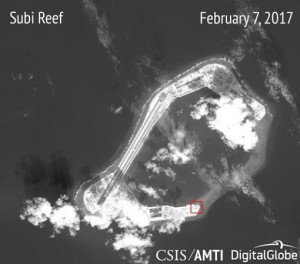US Sent An Aircraft-Carrier Strike Team, And There’s Nothing China Can Do About It
The last time USS Carl Vinson was deployed to the South China Sea was 2 years ago in 2015 when they conducted a bilateral exercise with the Royal Malaysian Navy and Royal Malaysian Air Force. First operated in the South China Sea in 1983, the Nimitz-class aircraft carrier has been deployed to South China Sea 16 times.
Last week (Feb 18), the U.S. Navy’s Carrier Strike Group 1 (CSG1) arrived in the South China Sea, beginning its “routine operations”. Besides aircraft carrier USS Carl Vinson, the strike group includes an entire destroyer squadron, and an additional Arleigh Burke class destroyer. Obviously, the operation carries another message – the U.S. still calls the shot.
A week before U.S. Navy carrier strike group entering the South China Sea, which represents one of the most powerful naval units in the world, China’s Foreign Ministry spokesman, Geng Shuang, had denounced the deployment. He said – “China has indisputable sovereignty over the South China Sea islands and their adjacent waters.”
While urging the U.S. to “refrain from challenging China’s sovereignty and security” in the sea, Geng Shuang also said – “China respects and upholds the freedom of navigation and overflight in the South China Sea which countries enjoy under international law.” Such statements appear to be contradictory, not to mention empty rhetoric.
China said it did not recognize an international tribunal ruling (July, 2016) at The Hague, Netherlands, after it said that China couldn’t claim historic rights in all the waters within a “nine-dash” line used by Beijing to delineate its South China Sea claims. China lays claim to almost all of the resource-rich South China Sea, through which about US$5 trillion worth of trade passes each year.
But if 90% of South China Sea belongs to China as it claims, doesn’t the so-called routine operations conducted by U.S. Navy carrier strike group led by USS Carl Vinson means an intrusion and invasion into China’s sovereignty and security? In the case of South China Sea, how can Beijing upholds its sovereignty while respects freedom of navigation at the same time?
The short answer is – China is incapable of protecting its property, South China Sea, at least not yet. Beijing can spin and twist as much as it likes but clearly, Washington is challenging China’s sovereignty. And there’s not a damn thing the Chinese can do about it. The most they can do is to issue condemnation and criticism, but that’s all.
The long answer is – China’s naval forces are is still at its infancy. The country still could not meet and match the Russian, let alone the American military on a global battlefront. More importantly, Beijing lacks real combat experience and as a consequence, their sexy equipments can only do so much. For this reason alone, the U.S. is calling China’s bluff.
For now, China can only bully Brunei, Malaysia, the Philippines, Taiwan and Vietnam, countries that also claim parts of the South China Sea that have rich fishing grounds, along with oil and gas deposits. But China isn’t planning to attack the United States military forces in the area anyway, until it’s being attacked first. China’s priority is defence.
China’s construction of man-made islands and build-up of military facilities in the sea has been a concern to the United States though. Almost two dozens buildings of what appear to be structures to house long-range surface-to-air missiles (SAM) have been reported. And Secretary of State Rex Tillerson wanted the island-building to be stopped.
However, like Geng Shuang’s empty threat that the U.S. should refrain from challenging China’s sovereignty in the South China Sea, Tillerson can only warn, cried and bitch about Chinese man-made-islands and military facilities. The U.S. Navy’s Carrier Strike Group can easily attack and send the missile structures into oblivion while it’s under construction now.
Trump administration, however, dares not attack those illegal military structures without starting a war with China. When the concrete structures with retractable roofs on all 7 islands, including Subi, Mischief and Fiery Cross reefs, are successfully built and installed with anti-aircraft and anti-missile systems, the military landscape in the South China Sea might change.
The fact is nobody, including the mighty United States, is able to enforce The Hague’s tribunal ruling and stop China from making more islands and installing more missile structures. Likewise, China isn’t able to stop the U.S. from challenging China’s sovereignty in the South China Sea. The U.S. will continue to promote freedom of navigation, and China can do nothing about it.
Other Articles That May Interest You …
- Trump’s Worst Enemies Aren’t Russia Or China – It’s Within America
- China Is Terrified – Trump Has The Power & Ability To Screw Its Economy
- China’s Naughty Act Of War – Snatches U.S. Navy Submarine Drone & Sails Away!!
- A Powerful & Vengeful President Trump – ISIS & Radical Muslims Are In Grave Trouble
- “War Message” To Japan And US!! – China Sends 40 Fighter Jets & Bombers To Okinawa
- Tribunal: No Basis To China’s South China Sea Claim, But Who Dares To Enforce It?
- Forget MARS – China Is Building A “Space Station” … Under South China Sea
- Why China Can “Take” Any Island In South China Sea … And Get Away
✍ Sumber : ☕ FinanceTwitter
Mukah Pages memuat-naik beraneka jenis artikel menarik setiap jam tanpa henti dari pelbagai sumber. 📲 📖 Enjoy dan jangan lupa untuk 👍 Like & 💕 Share!


























Post a Comment